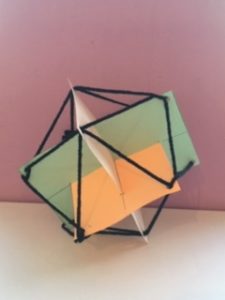 All the familiar space harmony forms are consistently made up of either central, transverse, or peripheral trajectories. In Part 2, however, Laban starts to mix tranverse and peripheral lines of motion to create some really interesting rings.
All the familiar space harmony forms are consistently made up of either central, transverse, or peripheral trajectories. In Part 2, however, Laban starts to mix tranverse and peripheral lines of motion to create some really interesting rings.
We explored, for example, mixed 2-rings. This designation is a misnomer, for mixed 2-rings are rectangles (aka 4-rings) arrayed in an interesting way in the kinesphere.
I refer to mixed 2-rings as “tilted planes.” There are 12 of these, each forming 4 sets of interlocking flat, steep, and flowing planes. They are similar to the interlocking cardinal planes, but the 2-rings are all tilted off-vertical. Their long edges are transversals taken from one of the A or B scales and linked with peripheral lines.
I quite like the tilted planes – performed seated, they really work range of motion in the shoulder. Seated or standing, they accustom the mover to oblique lines of motion and the location of the corners of the icosahedron. I think that must be how Laban used them in the 1920s – to familiarize students with a new geography of movement space.
My fellow decoders found 2-rings both simple and challenging. As one noted: “Subtle torso movement gets harder as we age, and practicing these simple 2-rings feels restorative and grounding, even though they are tilting.”
